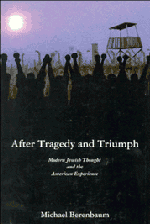Book contents
- Frontmatter
- Contents
- Foreword
- Introduction
- PART I THE HOLOCAUST IN CONTEMPORARY AMERICAN CULTURE
- PART II JEWISH THOUGHT AND MODERN HISTORY
- 8 Franz Rosenzweig and Martin Buber Reconsidered
- 9 The Problem of Pluralism in Contemporary Orthodoxy: Philosophy and Politics
- 10 From Auschwitz to Oslo: The Journey of Elie Wiesel
- 11 Jacob Neusner and the Renewal of an Ever-Dying People
- 12 Political Zionism's Would-Be Successors: Sectarianism, Messianism, Nationalism, and Secularism
- 13 The Situation of the American Jew
- Notes
- Index
9 - The Problem of Pluralism in Contemporary Orthodoxy: Philosophy and Politics
Published online by Cambridge University Press: 06 January 2010
- Frontmatter
- Contents
- Foreword
- Introduction
- PART I THE HOLOCAUST IN CONTEMPORARY AMERICAN CULTURE
- PART II JEWISH THOUGHT AND MODERN HISTORY
- 8 Franz Rosenzweig and Martin Buber Reconsidered
- 9 The Problem of Pluralism in Contemporary Orthodoxy: Philosophy and Politics
- 10 From Auschwitz to Oslo: The Journey of Elie Wiesel
- 11 Jacob Neusner and the Renewal of an Ever-Dying People
- 12 Political Zionism's Would-Be Successors: Sectarianism, Messianism, Nationalism, and Secularism
- 13 The Situation of the American Jew
- Notes
- Index
Summary
This chapter explores why modern (liberal) Orthodoxy has had difficulty maintaining itself despite the religious resurgence of Orthodox Judaism, which is antagonistic to religious pluralism. The self-ghettoization of contemporary Orthodoxy is analyzed in this chapter from a historical, sociological, and theological perspective, especially in the work of Joseph Soloveitchik, the intellectual godfather of modern Orthodoxy, who sought a bifurcated religious consciousness where religious faith is insulated from history.
Two of Soloveitchik's disciples, David Hartman and Irving Greenberg, dissent. They offer an Orthodox approach open to historical developments such as the Holocaust and the state of Israel. Embracing pluralism, these two men have defined the parameters of contemporary Orthodox Judaism – and may well be forced to stand outside of it.
In the quarter century since I received my high school diploma from Ramaz – then considered the most liberal of all Orthodox yeshivot in America – Orthodox Judaism in America has undergone a renaissance. Although Orthodox Jews still constitute a distinct minority among American Jewry's denominations, Orthodoxy is now distinguished by a newfound sense of confidence and power. It has recovered from its precarious situation of a generation ago.
Orthodoxy now has momentum. When I was being raised, a sense of erosion plagued traditional Judaism. Seemingly, each generation of American Jewry was becoming less observant than its predecessor, less committed to tradition, less reliable in its religious beliefs. Orthodox Jews keenly felt the lure of the world beyond the community. Even for those who remained faithful, the outside world was an option – better yet, a temptation.
- Type
- Chapter
- Information
- After Tragedy and TriumphEssays in Modern Jewish Thought and the American Experience, pp. 101 - 116Publisher: Cambridge University PressPrint publication year: 1990

